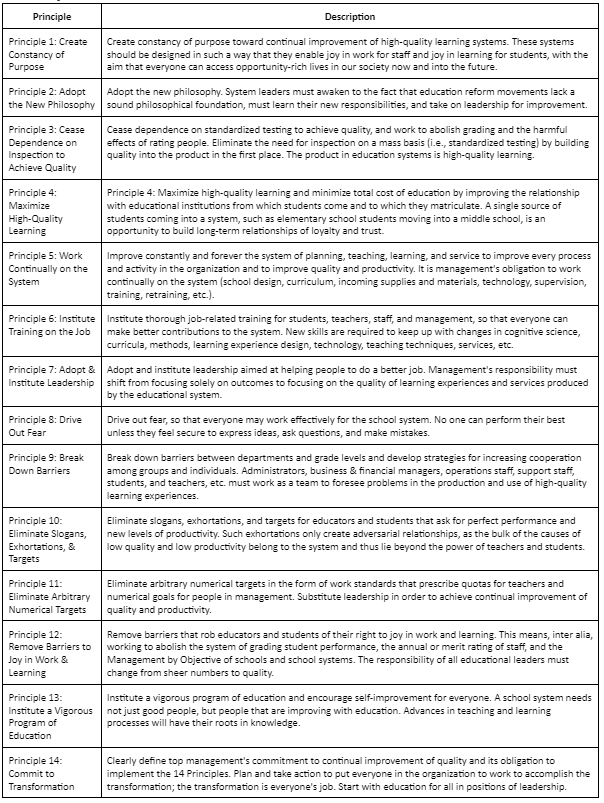14 Principles for Transformation: A Recap
Since April, I’ve been writing about the 14 Principles for Educational Systems Transformation. In this final post of the series, I’m providing some clarifying information that will assist anyone that decides to go on their own learning journey of the 14 Principles. I’ve also included a summary of the principles in the table below.
Clarifying Information
W. Edwards Deming’s 14 Points didn’t exist in the 1950s when he started working with Japanese business leaders on how to transform their organizations. They were developed gradually over a roughly 20-year period from the 1970s to the early 1990s and didn’t reach the number 14 until Deming started to present his four-day seminars in the United States. The list was expanded as the focus of his work shifted from Japan to the United States. There were certain principles such as “Drive out fear” and “Remove the barriers that rob the hourly worker of his right to pride of workmanship” that did not have to be told to Japanese management, but they did need to be addressed in the U.S.
Additionally, there are a few other items that are worth clarifying. First, Deming sometimes referred to his 14 Points as “Principles” or “Obligations” of management. For consistency’s sake, I refer to my list as the 14 Principles in the series and in my book. Second, Deming’s 14 Points are not in and of themselves his philosophy, but they are important components of it. They are not a recipe nor a checklist to be implemented, but rather principles that are meant to open up your mind to a whole new way of thinking in regard to how we organize and run our educational institutions. Finally, and most importantly, Deming’s 14 Points are interlinked principles within a larger management philosophy. As such, you can’t simply put the points into action without first developing a deep understanding for why Deming wrote them in the way that he did. The transition to transformation must account for your organization’s particular context, so the principles should not be adopted without this deep understanding and appreciation for that context. Continual improvement guided by the 14 Principles is not a project or program to be implemented, but rather a never-ending commitment to quality. With that mindset framing in hand, a recap of each of the principles that have been discussed in this series follows.[1]
Table 1. 14 Principles for Educational Systems Transformation
Blog Series: 14 Principles for Educational Systems Transformation
The four components of the System of Profound Knowledge work in concert to provide us with profound insights about how our organizations operate so that leaders can in turn work to optimize the whole of our systems. However, there is a step beyond simply avoiding the management myths. The next step is to be able to think and make decisions using the lens provided by the System of Profound Knowledge. This is where the core set of 14 Principles come into play. In this series, I’ve been describing the principles that will enable you to move from theory to practice with the Deming philosophy.
***
John A. Dues is the Chief Learning Officer for United Schools Network, a nonprofit charter management organization that supports four public charter schools in Columbus, Ohio. He is also the author of the newly released book Win-Win: W. Edwards Deming, the System of Profound Knowledge, and the Science of Improving Schools. Send feedback to jdues@unitedschoolsnetwork.org.
Notes
Henry R. Neave, The Deming Dimension (Knoxville, Tennessee: SPC Press, 1990).


